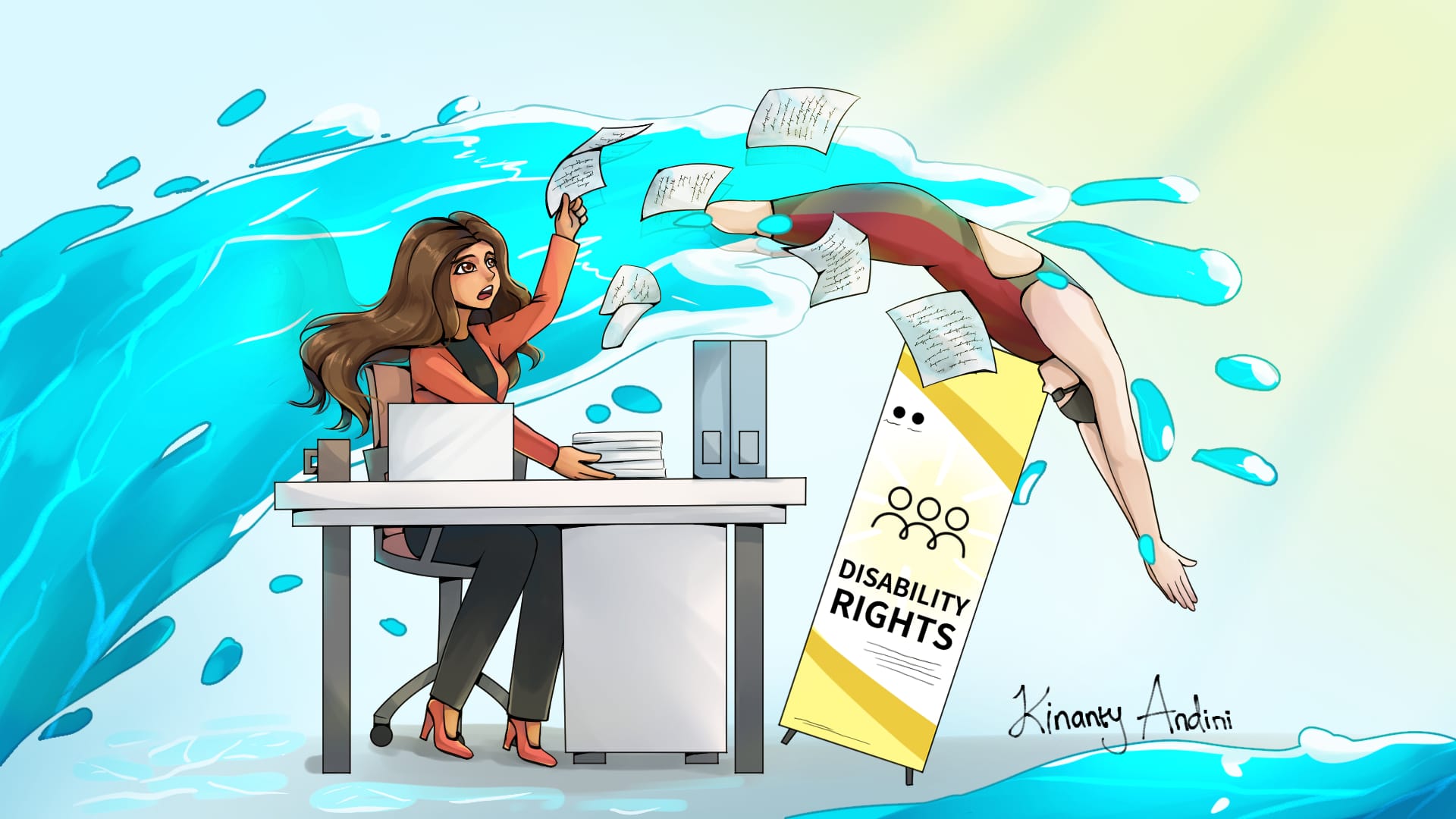Paralympic Paradoxes

Dear Debriefers,
The Paralympic movement and its relationship with disability advocacy is, in a phrase, paradoxical.
On the one hand, you have an international sporting movement that purports to support the lives of disabled athletes on and off the field of play. Thousands of disabled people descend on a city every two years. And for decades, you have loud disabled voices making themselves known.
And yet, the Paralympics’ bar for participation is a classification code based upon diagnoses and various sporting protocols that are ostensibly about what you can do but are largely focused on what you can’t do. The organisation, like its non-disabled sibling, believes itself to be apolitical, and it’s not clear that lives of disabled people are improved after the event ends.
Despite the fact that both advocacy and sporting movements say they are working for a better world for disabled people, there is a rift between them. Today, we’re going to look at why that is, and why I believe there’s more common ground than we usually find.
Guest essays like this one are made possible by support from readers. Thanks to Kathleen and Stephane for new contributions.
For more resources: see the Debrief library on Sports and the Paralympics.
Jocks and Nerds
Part of the challenge in getting disability policy and disability sports folks to find common ground is that they tend to be in different worlds.
Athletes publish memoirs with inspirational titles, and the media programming shares voices of those spelling out inspirational notions. The advocates’ argument against inspiration-based messages is that disability isn’t exceptional.
But elite athletes are exceptional. Para-athletes choose (or are compelled) to use inspiration as a cloak to protect themselves. If you’re used to insults poking fun at your differences, I think it’s natural to grab onto a word that people are using to praise you.
And on the other side, the majority of activists or advocates I know were never involved in Para sport. They were told they had to sit in the corner, or that they might get hurt, or that there wasn’t space for them—sometimes by Para sport organisations themselves.
It’s the jock versus nerd debate all over again, except many of the athletes are also nerds and many of the nerds wish they could have learned accessible movement.
The paradox of Para sport
Some of the tensions between disability rights and the Paralympics are built into the Paralympics themselves. Disability rights are about levelling the playing field without any exceptions. Sports are about fairness of competition that leads to winners and losers.
And Para sports have to create a system that makes a fairer competition between people with different abilities. This is done through an evolving system of classification, meant to group athletes so that those with similar abilities can compete against each other. And for team sports like wheelchair basketball or wheelchair rugby, classifications link to point values and teams can only have players with so many points in play at one time.
The classification code tells disabled people whether they are disabled enough to be recognised as an athlete or not. And from there it creates a culture of people policing each other and, indeed, of folk bending the rules. Like many other systems that determine who is in or outside of a disability space, it is fundamentally imperfect and, as a result, exclusionary.
Ways into disability community
Someone who can speak to both sides of the divide is Rebecca Cokley, a prominent advocate in the United States. Before she worked in the Obama administration, and before she took her current position at the Ford Foundation, she was watching her godmother play for a local wheelchair rugby team, the Quadzillas:
“Another way that I was brought into disability community was meeting all these different people who played quad rugby and watching them compete all over the state. And watching my godmother who has a different form of dwarfism than I have being hyper aggressive. In the dwarfism community, we often talk about being really careful about your body. And watching the Quadzillas grab a dude and throw them out of the chair… I remember watching her play a lot. At the time, in the dwarfism community, there wasn't youth sports.”
Beyond the great team name, there was a sense for Cokley that this was a place where community could and should be built. While not someone who considered herself an athlete – she says her athletic career ended in middle school – that disconnect between the Para sport and the broader disability policy world is something she sees:
“I think it's easy, if not lazy, for people in the disability policy space to spend it with people with the same types of disabilities and only that, and it really limits your ability to see the tapestry of what disability is. And so I think Para sports is an opportunity for that.”
Cokley sees Para sport and the world of activism and disability policy to be at their best when they’re working through the lens of interdependence. Whether it’s the Independent Living or disability pride movements, the Capitol Crawl and the establishment of the Americans with Disabilities Act, or the current battle against Medical Assistance in Dying Legislation. All of these actions require an interdependence, a willingness to figuratively (and sometimes literally) lean on each other.
And at their best, sports can do even more than that. They can express an important side of humanity particularly important for disabled people to reclaim. For Cokley, connecting with Para sport athletes allowed her to see how talents could translate from the court to the boardroom, from sport to life:
“It allowed me to have sort of the perception of both the Bruce Wayne and the Batman [sides of] folks… Outside society will look at them and be like, ‘What kind of life can somebody have who has that kind of disability? And I'm like, Dude, did you not just see him throw that dude that outweighs him by 200 pounds out of this chair? And then tomorrow, he's going to go nail a deal for a real estate holding.”
Recruiting from the street
There’s also a less positive thing that both Para sport and disability advocacy have in common. Both reflect and reproduce social inequalities.
In both areas, the leading voices tend to be male, white, and from rich parts of the world. In Para sports gender inequities are incredibly clear when you look at how few women are involved compared to men, and there is a glaring lack of racial diversity in the makeup of leading Para sport nations like Canada.
Inequalities are visible in the state of equipment and resourcing athletes arrive with. They’re also visible in impairments. It wasn’t that long ago that polio was one of the main conditions creating quad rugby players in the global south just the same way as driving laws that lacked seatbelt restrictions created wheelchair rugby players forty years ago.
A frequent joke is that some Para sports find new athletes on the street, some are found in rehab centres, and some come straight from the emergency room. I knew coaches who would joke that seatbelt laws really put a damper on recruiting.
To some extent these inequalities are being addressed, and the disparity between countries is lessening. South American teams are now pushing themselves into the higher echelons of wheelchair rugby, and more and more athletes from outside of Europe and North America are excelling in individual sports.
Sports in society
Dr. Andrea Bundon studies Para sport through the lens of social inequities and has been involved in the past as an athlete guide. She says that Para sport organisations could do more to understand themselves as part of the broader disability sphere:
“In Para sports, the focus is so much on the sport and so much less on, I think, what's happening in disability communities. And there's so much that could be learned there and that could cross [over]. But the model I see, it feels a bit more [like] we took a sport system and we added disability to it. It's a retrofit.”
An elite sport approach can leave behind some disabled people and other ways society can be improved. Bundon sees a sport system that is trying to integrate or provide opportunities but sometimes genuinely unaware “that their efforts are not being received the same way across all disability communities”. She takes us back to the paradox between sport and inclusion:
“There is a real tension between elite sport that is premised on a hierarchy of bodies, that is ultimately about trying to find the fittest and most able bodied […] So, it's allowed some disabled people to enter that space, but mostly those who are closest to or are able to achieve work towards that idealised athletic body and then it creates some opportunities for some disabled people, but leaves many, many more behind.”
A common ground on the other side
A friend and I used to talk about how Para sports athletes only realise just how much they have in common with broader disability activist community when they retire.
I personally never got anything even close to the Paralympics. I got an email about being on the Canadian long list once for wheelchair basketball. But it was clear that it would take a disaster or two for my services to be needed.
Para sport, at the elite level—or, in my case, wishing I was elite level—can be incredibly isolating and selfish. You need to have a singular focus on the task at hand and that can mean inadvertently leaving others in the dust. My own time in Para sport left me with guilt and a need to reflect. It is to my eternal shame that I saw homophobia and transphobia without speaking up properly.
Where do we go from here? Barring some Crip Camp-style group singing session where everyone comes together and agrees that athletes and activists are one and the same—and I’m not holding my breath–what we can focus on is how crossover happens.
Bringing disability policy and Para sport people together, for me, is about cross-disability organising. The non-disabled split us up a fair amount anyway, why give them another reason to do so?
Athletes can use their voice, particularly after they retire, for social causes. Policy folks need to understand movement and sport independently of the ableism around them in public perceptions. There’s more common ground, sporting or otherwise, than we might expect.
Cheers,
John
Acknowledgements
Many thanks to Kinanty Andini for the illustration.
A big thank you to Rebecca, Andrea and Puneet. Also a thank you to my teammates, coaches, and friends, whose influence—whether they are still alive or not—I carry on in my writing.
The Debrief is made possible by support from individuals and organisations.
Lastly, all writing benefits from a talented editor and Peter definitely is that.
